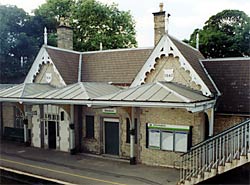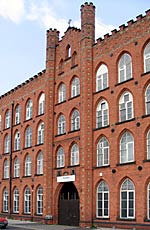
The railway station, Beeston, was built in 1847 for the Midland Railway (photo: A Nicholson, 2003).
Transit. The Nottingham and Derby Road, called in 1801 Derbigate, was turnpiked in 1758-9, and disturnpiked in 1870. A branch of the Nottingham and Ash by Turnpike Road, usually called the Sawley branch, went through Beeston. In 1831 an advertisement of the four-horse coach from Nottingham to Birmingham stated that the coach calls at Beeston daily at 8.30 a.m., and in the opposite direction at 3.30 p.m. The Canal from the Trent, via Nottingham and Lenton, to Langley Mill, was completed in 1802. A branch canal from Lenton chain to Beeston Cut was made by the Trent Navigation Company under an Act passed in 1794, and it involved the necessity for the weir at the Ryelands to hold up the water to supply the canal through to Trent Bridge. The Midland Railway from Nottingham to Derby was opened with great demonstrations of rejoicing on May 30th 1839. The crowds of people that assembled on Sundays at Beeston Station to go to Nottingham was then so great as quite to upset the ordinary provision. A little cabin sufficed for the stationmaster's residence, and for the traffic, but a larger disused station-house was in 1847 removed from Southwell to Beeston. A note of progress is recorded in the almanack for 1882, when there were thirty-five trains daily to Nottingham and thirty-six back, third-class season tickets being 15/- per quarter, with 450 quarterly ticket-holders, and 170,000 ordinary passengers in the year from Beeston. There are in 1915 above 100 trains per day, besides minerals and goods, and trains not stopping. A report in the Express of Dec. 15th, 1905, says "There are over 1,000 season ticket-holders."
Motor Buses now run to and from Nottingham nine or ten times a day each way.
Industries. The old industry of the parish was, of course, agriculture, so in the parish registers men are often described as husbandmen, and from the nature of the soil, its running brooks, and big river, the dairy produce would probably prevail, while its proximity to the county town, and its good roads would encourage town requirements to be grown.
The Hosiery industry appeared early in the 18th century, so in the parish register men are frequently described as F.W.K. (framework-knitter), and the trade developed so rapidly that there were in 1845 two hundred and sixty-three hosiery frames in the parish. So deposed Mr. Wm. Felkin before the Commissioner appointed to enquire into the condition of the framework-knitters. The workers had doubtless suffered as in all the other villages in the time of the Luddite outrages in 1811-12 and following years, when the frame-breaking riots were prevailing, but I have not seen that the evil was encouraged or practised in Beeston. Probably "Watch and Ward" would be kept; blunderbuses and swords for the constables may have been obtained, and soldiers may have been billeted, but the horrors of war, and the disruption of trade were endured.
From the mass of evidence taken in 1845 we will listen to the deposition of Samuel Goodwin Horsley, of Beeston, who gave evidence on behalf of his fellow-workmen. His was the wrought cotton hose branch. He said there were about 250 frames in Beeston. He worked full women's size at 10s. 9d. a dozen. The workers were badly off indeed. A local master worked to a large Nottingham firm, and took his work in once a month, or five weeks, and the hands that work to him had to live out of their money, with the exception of a few odd hose, all that time, and consequently were living under great privation. He had been "trucked" seventeen weeks [that is paid by provisions instead of money for wages], and all that time received but threepence, and was obliged to beg. He was paid in bread, soap, sugar, candles, and a bit of bacon when he could catch it. Sometimes had to go on Sundays without a bit of animal food. Frequently sold bread at a penny a loaf less than it cost him. There was one field of seven acres let in about twenty garden allotments, for which £6 an acre was charged, or 15/- for 600 yards. He complained of the infringements with regard to the widths and lengths of the hose, etc. We thus see the wretched condition of the men, and little help came from the enquiry, except that the law against "truck" was more vigilantly enforced, and many years afterwards frame rents were very properly abolished, but the industry was a dying one, steam, improved machinery, and the factory system were coming in, and now the old hand-frames are regarded as curiosities of a past generation.
Silk Doubling was introduced probably early in the last century, when the Mill was built, but it gradually became a very poor trade for both manufacturers and workpeople. The machinery became old-fashioned, and the low wages paid in Italy, where the silk was largely produced, and the miserable wages for which people worked at Macclesfield and Spittlefields, pulled down wages at Beeston, although the best work was done here. Mr. R. Lowe states that in 1862 the men earned 13/6 per week, and the women 7/- or 8/-, working from 6 to 6, with 11/2 hours off (see page 17). The silk industry almost entirely departed from our county.
 Anglo-Scotian
Mills, Beeston (photo: A Nicholson, 2005).
Anglo-Scotian
Mills, Beeston (photo: A Nicholson, 2005).The Lace Trade may have been introduced to Beeston in the early part of the last century. Blackner tells us that from 1807-10 the average earnings of the workmen were about 20/- per week. Frame rents were increased from 1/9 to 2/6 per week; thereupon many persons bought frames, and this led to a reduction in prices. The establishment of payment by the "rack" was a great benefit. When the great boom in the lace trade occurred in 1824, by reason of the expiration of Mr. Heathcoat's patent, and everybody in the trade thought to get rich in little time, it is probable there were many men in Beeston who obtained frames, and worked them in the upper rooms of their houses. In 1833 there were in Beeston upwards of 100 bobbin net lace machines, which were described in 1850 as lace machines, there being then 150 of them. Gradually these were got into small factories, steam power superseded the hand-machines, and wider machines the narrow ones, and other considerable developments occurred, much of which was abont 1840, when Robert and William Felkin had small factories for hosiery and plain net manufacture. William Limb and Matthew Salt were in the fancy lace trade. William Cox was in fancy silk laces. Thomas Pollard started in fancy lace, a business developed by his son John, and John bought the factory of William Elliott, who about 1846 put the first Manchester Jacquard to work the Leavers machine, and now the Pollard plant is the largest in the district. William Kirkland in 1844 had travers warp machines, and developed the business Henry Kirkland had established in 1819. About 1871 Frank Wilkinson commenced in the fancy warp and Shetland fall trade, afterwards going into the lace curtain trade and developing it considerably, building the Anglo-Scotian Mills on the site of Felkin's old factory. A disastrous fire occurred on April 29th, 1886, affecting several hundreds of hands, as well as involving heavy loss. There was another fire on April 29th, 1892, but the premises were re-built, and are let by Mr. A. J. Pollard to various tenants.
Machine building was carried on by Messrs. Humphrey, Botham and Wyer in 1850, but they afterwards removed to Radford. Messrs. Wm. Wragg and Wm. Pilgrim had a machine-building business in 1874.
Cycles. It was a great advantage to Beeston when the Humber Company decided to establish works at Beeston. Thomas Humber was a mechanic, who in 1868, in a blacksmith's shop in Nottingham, used, with the aid of his wife, to turn out what were known as "Velocipedes," at the rate of about one per week. These were made after the design of one described in the "English Mechanic" as having come from France, but dumber improved on the original machine, and eventually improved on the "Spider" wheel bicycle. The concern developed into a Limited Liability Company in 1887, and works were built and fully occupied, so that when the Company determined to concentrate their works at Coventry they were employing in Beeston between 1,400 and 1,500 hands. The cessation of the works involved a removal of about 3,000 of the population, and 600 houses became empty. The factory was purchased by Mr. A. W. Black, M.P., and became a lace factory.
There were Cycle works built by Messrs. Humber & Goddard, south-west of the Railway Station, but these works were afterwards purchased and vastly enlarged by a Company partly Swedish—The British L. M. Ericsson Manufacturing Co. Ltd., for the manufacture of telephonic apparatus, in which above a thousand hands have been employed.
Horticultural Buildings are largely constructed here by Messrs. Foster & Pearson Ltd., who developed a business started about the middle of the last century. The Beeston Foundery Co. Ld. have made the Beeston Boiler known throughout Britain and foreign parts. Lace, Hosiery and Art Printing furnish a variety of occupations, and the Railway Co. at their creosoting works and their extensive shunting sidings employ many men.
Horticulture has of late years been considerably developed in the parish. To cottage gardens, ornamental grounds, and planted orchards there has been added the growth of roses, and other flowers on a large scale, and with considerable success. Several nursery grounds are established here, one or two of 60-70 acres in extent, where practically every known variety of tree, shrub or plant can be acquired. These Nurseries are generally open for visitors to view, and during the spring and summer months are well worth a visit.
All the industries in Beeston have been profoundly affected by the war—by the departure of men to the front, by requirements as to war work, by the erection of great Government works in the neighbourhood, by the substitution of female labour, and otherwise, so that when business returns to its normal condition there will require much mutual forbearance and concession.
